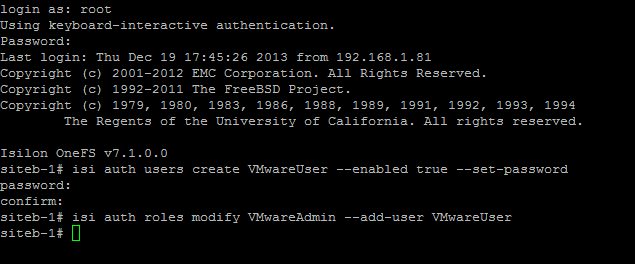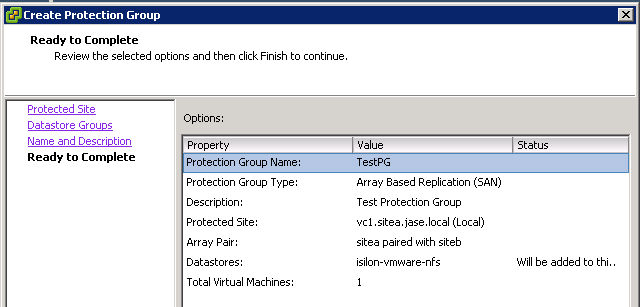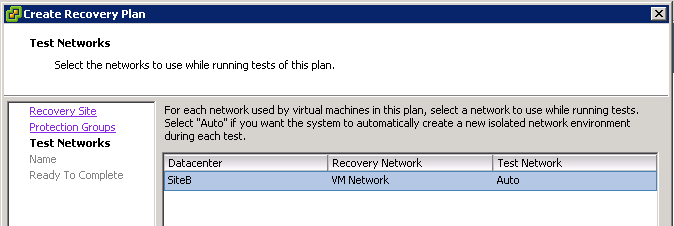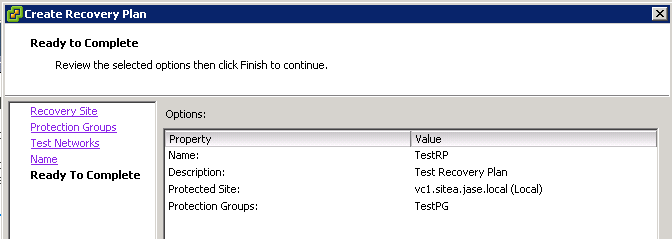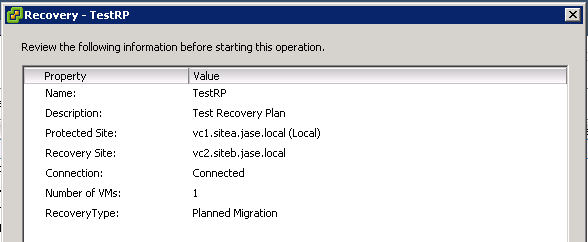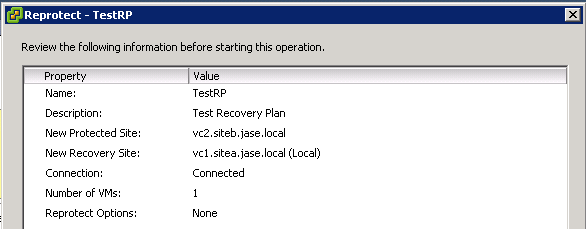I’ve tried this before
It seems like it was just yesterday that I was talking with Bas Raayman about this. Looking back at emails, it was actually about two years ago.
When the Isilon Storage Replication Adapter 1.0 (SRA) for VMware Site Recovery Manager 5.0 (SRM) came out, it was clunky to say the least.
Before installing the SRA on your SRM server, there was a lot of work that had to be done. There was a java tool used to configure the source & target directories, the different array IDs being used, and blah, blah, blah. Not to mention the way things were replicated back and forth I didn’t quite follow.
Maybe I just didn’t get it. Sometimes I’m a little slow and forget things, or at least that’s what Mike Colson might tell you after following me around in his first quarter as a new vSpecialist on the EMC Federal team.
New version
It looks like the team at Isilon has worked pretty hard to make things easy for old folks like me. The 2.0 version of the Isilon SRA is MUCH, and I mean MUCH easier than before.
As always, there are some minimum requirements that need to be met before attempting to be successful.
Those requirements are (from the docs)
- Primary & Secondary clusters must be running OneFS 7.1 or later
(sorry for those still on 6.5.x or 7.0.x) - SyncIQ licenses must be configured on both Primary & Secondary clusters
- SnapshotIQ licenses must be configured on both Primary & Secondary clusters
- VMware vCenter Site Recovery Manager must be 5.1 or later (more on that in a minute)
- VMware vCenter must be version 5.1 or later
Or Later…
Rob Peglar mentioned to me a couple weeks back that the SRA 2.0 was validated for VMware vCenter Site Recovery Manager 5.1.1.
I looked that the VMware HCL site (http://www.vmware.com/go/hcl) and noticed that the Isilon SRA 2.0 is ONLY supported with SRM 5.1 Update 1 and SRM 5.1 (despite the “or later” mentioned above).
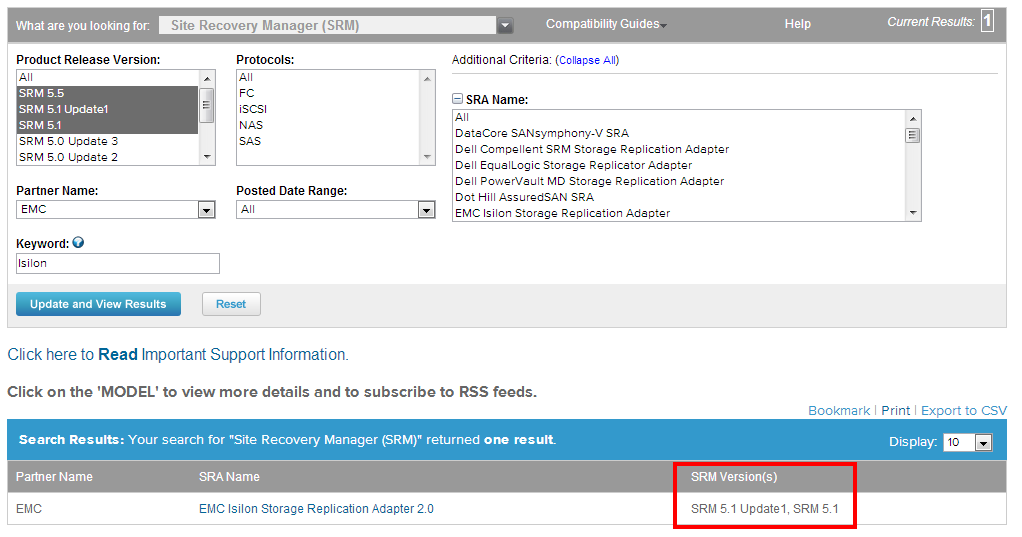
Now on to the setup
I’m not going to go deep into the VMware SRM configuration, other than how it interacts with Isilon.
The install process is basically as follows (provided all licenses are in place):
- Install the SRA on both of the SRM servers running in the Primary & Secondary site
- Configure the SyncIQ replication policy
- Create the Array Managers for Isilon
- Setup Protection Groups
- Setup Recovery Plans
- Failover & Reprotect
- Failback & Reprotect
Installing the SRA msi is pretty quick/painless, so I’ll skip that, but you can get it from here:
https://my.vmware.com/web/vmware/details?downloadGroup=SRM5111&productId=291&rPId=3727
Make sure to Rescan SRAs to ensure that SRM knows the Isilon SRA 2.0 is there…
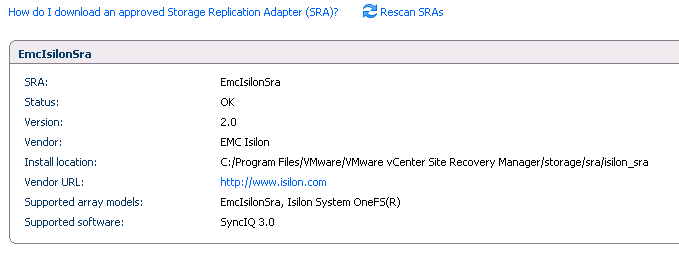
Escalated Isilon Cluster Access
Unless you want to run everything under root credentials, I’d recommend (as well as the release notes) running the SRM processes as a dedicated user.
To do this, log into the console of each Isilon cluster, and run the following commands:
- Create a VMware User
isi auth users create VMwareUser –enabled true –set-password - Set the appropriate Group Membership
isi auth roles modify VMwareAdmin –add-user VMwareUser
(this is correct, rather than VMwareAdmin in the Release Notes)
Configuring SyncIQ
From the Isilon UI on the Primary Isilon cluster, click on DATA PROTECTION, then SyncIQ, then Policies, then Create a SyncIQ Policy.

For the name, I chose SRM-REPL, and the action Synchronize.
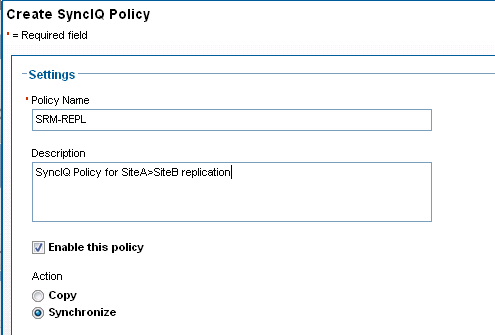
Then I set the Daily schedule to replicate every 30 minutes.
(Remember to set this to an interval appropriate for your environment).
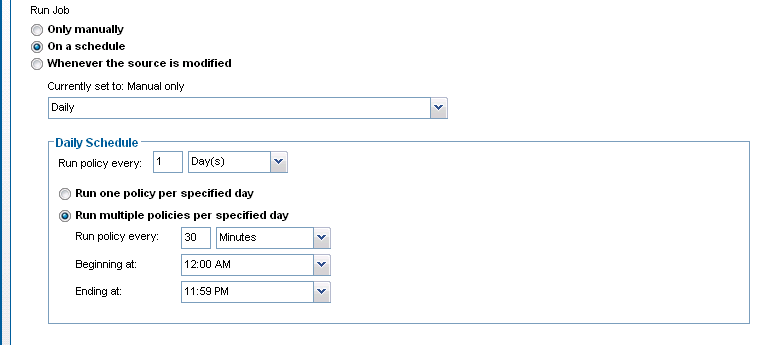
Only setup the Source Root Directory, not any included/excluded directories.

Setup the target cluster (SiteB for me)

Click Create Policy
Configure VMware vCenter Site Recovery Manager
Now that the policy is made (only on the Primary Isilon Cluster), the SRM configuration can begin.
Array Managers
In SRM, Array Managers have to be configured, so it will know which array is talking to which other array. In the SRA 1.0 for Isilon, this was a little clunky, and much of it was setup outside of SRM.
After clicking on the Site Recovery icon in the vSphere Client, go to Array Managers, and right click on the Primary site (vc1.sitea.jase.local in my case), and click on Add Array Manager.
I picked a Display Name of Isilon, and the SRA Type EmcIsilonSra.

Then enter the Primary Isilon Cluster Address (can be FQDN or IP of any node in the cluster) , the SyncIQ Policy that was created, and user credentials.
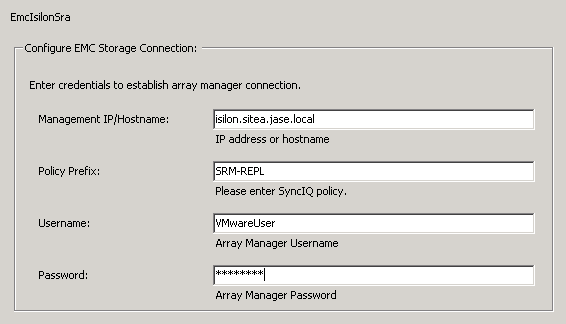
I used the SmartConnect FQDN, SRM-REPL, and the VMwareUser credentials I created.
In Array Managers repeat the steps for the Secondary site
(vc2.siteb.jase.local in my case).
When both Primary and Secondary are configured, Enable the Array Pair.

Protection Groups & Recovery Plans
Now create your Protection Group by right clicking on All Protection Groups.
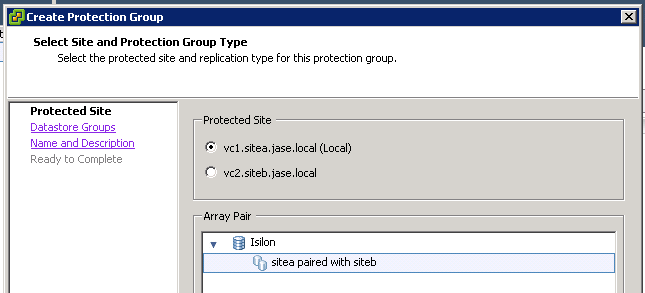
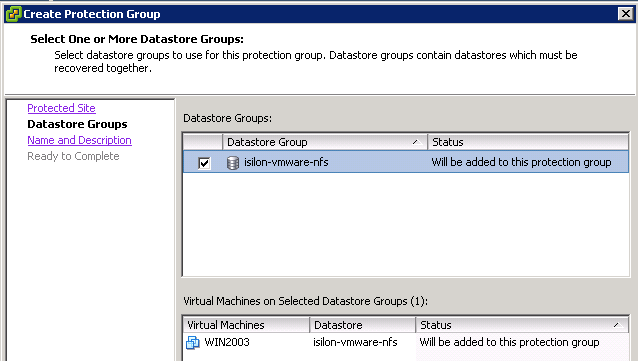
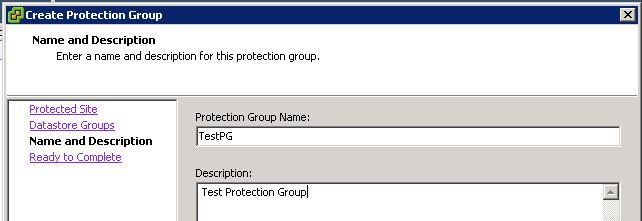
The Moment of Truth – Recovery
This is where the SRA 1.0 version gave me the most trouble… In 2.0 it is much better.
When ready to initiate a failover, select the Recovery Plan (TestRP for me) in the left pane, and click Recovery Steps in the right pane. Click Recovery to Failover.
When presented with the Recovery Confirmation window, select “I understand that this process blah, blah, blah” and the Recovery Type you wish to use.
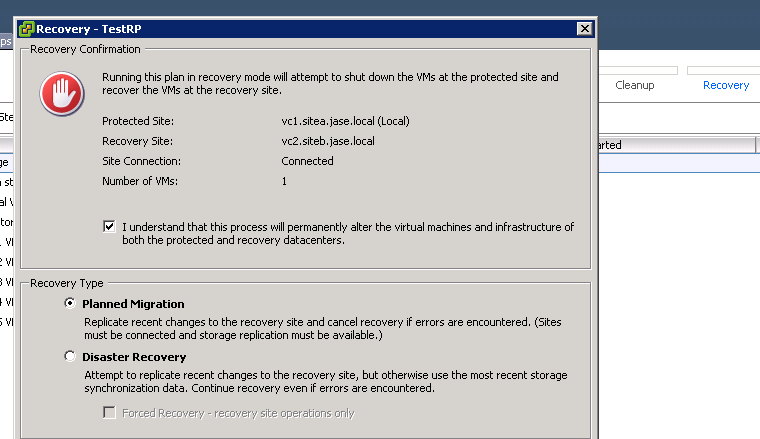
Failing over the the Secondary Site (siteb)
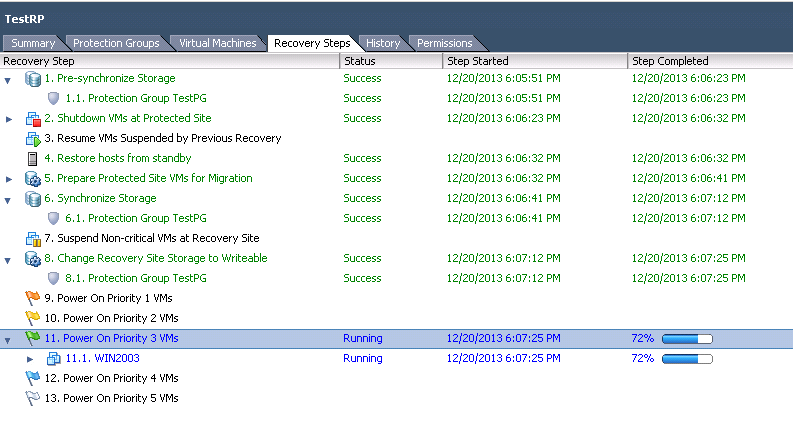
Because I want to be able to failback quickly/easily, I select Reprotect to complete the process of the Secondary becoming Primary, and Primary becoming Secondary.
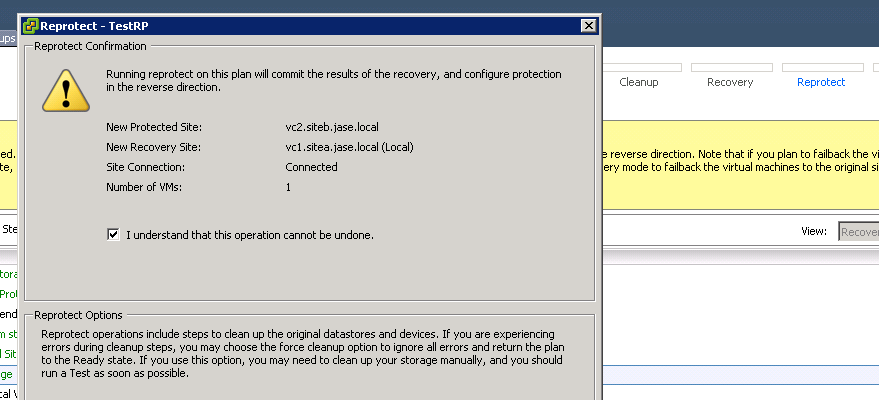
The Moment of Truth – Failback Recovery
After I’ve Reprotected, I want to fail back, moving my VM back to SiteA.
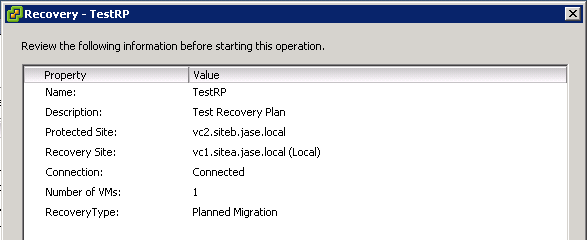
And I’m completely migrated back…
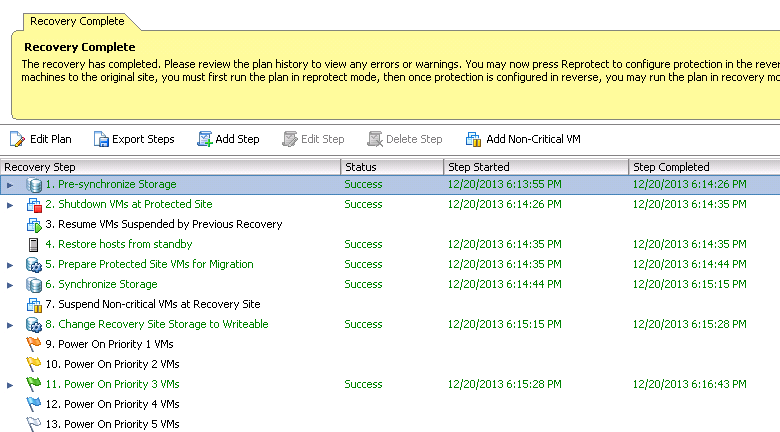
Don’t forget to Reprotect.
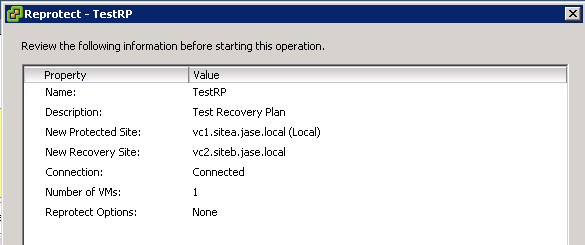
Whew – That was easy
Much easier than the last time I attempted it… I have to say that the EMC Isilon team has really done a great job on the 2.0 version of the Isilon SRA for VMware SRM.
I set all of this up in my lab, in a couple hours
(had to install 2 new VC’s, 2 ESXi hosts, SRM, & 2 Isilon OneFS 7.1 Clusters).
As can be seen from the instructions above, it is a pretty simple process.
Remember to get the SRA here (with the included documentation:
https://my.vmware.com/web/vmware/details?downloadGroup=SRM5111&productId=291&rPId=3727
From an Isilon perspective, all you need on the Isilon site, is OneFS 7.1 and SyncIQ/SnapshotIQ licensed on both Primary & Secondary Isilon Clusters.
Again, kudos to the EMC Isilon team who put this together. Great job!

